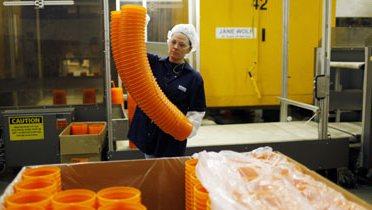Recommendations: Analysis of data on vacancies and unemployment, as well as data on geographic and industry skill mismatch finds no evidence that unemployment is mainly due to a mismatch of jobs and workers. Instead, an increase in demand for goods and services would almost certainly bring down the unemployment rate. This could be accomplished by more aggressive fiscal and monetary policy. Fiscal retrenchment in the short run is likely to increase unemployment even though long term structural deficits must be dealt with in a credible way.
“Mr. Plosser’s answer is unequivocal: This mess was caused by over-investment in housing, and bringing down unemployment will be a gradual process. ‘You can’t change the carpenter into a nurse easily, and you can’t change the mortgage broker into a computer expert in a manufacturing plant very easily. Eventually that stuff will sort itself out. People will be retrained and they’ll find jobs in other industries. But monetary policy can’t retrain people. Monetary policy can’t fix those problems.’”
—Mary O’Grady, The Wall Street Journal
February 14, 2011
“Monetary stimulus has provided conditions so that manufacturing plants want to hire new workers. But the Fed does not have a means to transform construction workers into manufacturing workers. Of course, the key question is: How much of the current unemployment rate is really due to mismatch, as opposed to conditions that the Fed can readily ameliorate? The answer seems to be a lot…. Most of the existing unemployment represents mismatch that is not readily amenable to monetary policy.”
—Narayana Kocherlakota
Speech at Northern Michigan University
Marquette, Michigan
August 17, 2010
Charles Plosser and Narayana Kocherlakota are Presidents of the Philadelphia and Minnesota Federal Reserve Banks respectively. If they are right then there is certainly no point in continued efforts by the Federal Reserve to increase demand for goods and services by bring down long term interest rates or for the congress to consider additional fiscal stimulus. However, I have recently examined a wide range of data, including that on which President Kocherlakota based his conclusion, and I believe a very different conclusion is warranted. While it is likely that there has been a decline in the efficiency with which the labor market matches jobs and workers, that decline in efficiency explains only a small fraction of the huge increase in unemployment since the onset of our most recent recession. Further, the most likely explanation for that decline in efficiency is the extension of unemployment benefits to the long-term unemployed. What doesn’t seem to have played much, if any, role in increasing unemployment is either the geographic or industrial mismatch of workers. Demand for workers is depressed across the board. While there may be very small geographic or occupational niches where workers are in short supply, such bottlenecks always exist in the labor market and data suggest that such bottlenecks are actually at a low ebb.




